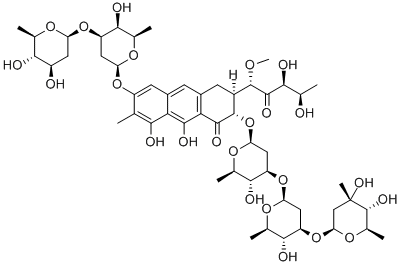| Reference | 1. Leuk Res. 1997 May;21(5):375-80.
<br>
A pilot study of alpha-interferon and plicamycin for accelerated phase of chronic
myeloid leukemia.
<br>
Dutcher JP(1), Coletti D, Paietta E, Wiernik PH.
<br>
Author information: <br>
(1)Department of Oncology, Montefiore Medical Center/Albert Einstein Cancer
Center, Bronx, NY 10467, USA.
<br>
Thirteen patients with accelerated phase of chronic myeloid leukemia (CML-AC)
were treated with intravenous plicamycin and subcutaneous alpha-interferon. Two
patients stabilized, three patients had partial hematologic responses and one
patient had a hematologic complete response with a major cytogenetic response.
Two patients, progressing on hydroxyurea, did not respond, but demonstrated
re-sensitization to hydroxyurea after completion of induction therapy and had
prolonged return to chronic phase for 30 months and 25 months. Four
non-responders subsequently received additional chemotherapy and responded.
Median survival of all study patients from the development of accelerated phase
of CML was 24 months: substantially longer than other reported series (median 6
months). Plicamycin appears to add efficacy to interferon in the stabilization of
accelerated phase of CML.
<br>
2. Haematologica. 1990 Sep-Oct;75(5):443-6.
<br>
The plicamycin and hydroxyurea combination chemotherapy for chronic granulocytic
leukemia in myeloid transformation.
<br>
Antimi M(1), Masi M, Delannoy A, Ferrant A, Doyen C, Debusscher L, Delwiche F,
Stryckmans P, Papa G.
<br>
Author information: <br>
(1)Istituto di Ematologia, II Università, Roma, Italy.
<br>
Between 1987-1988 we treated, in a cooperative study, 13 patients in blast crisis
of CGL according to Koller and Miller/’s regimen. We observed no return to the
chronic phase of the disease, while some patients suffered major drug-induced
side effects. Six patients in accelerated phase were treated with the same
combination therapy. All of them responded with a return to the chronic phase for
a median of 4.5 months. In our hands the combination of plicamycin and
hydroxyurea was ineffective in patients with CGL in blast crisis. This regimen
could deserve further evaluation in patients with CGL in acceleration.
<br>
3. Leuk Res. 1987;11(12):1089-92.
<br>
Differentiation of blasts from patients in myeloid crisis of chronic myelogenous
leukemia by in-vivo and in-vitro plicamycin treatment.
<br>
Sampi K(1), Hozumi M, Kumai R, Honma Y, Sakurai M.
<br>
Author information: <br>
(1)Hematology Clinic, Saitama Cancer Center Hospital, Japan.
<br>
Two cases in myeloid blast phase of chronic myelogenous leukemia (CML) responded
to treatment with plicamycin alone. Their total white blood cell (WBC) count and
immature myeloid cells fell in one case rapidly and in the other gradually.
Approximately two to three weeks after initiation of plicamycin their total WBC
count began to rise again, whereas the mature myeloid cells remained constant
throughout the treatment. These results suggest that plicamycin may be effective
in suppressing proliferation of blasts and promoting their maturation in the
myeloid blast phase of CML, but that plicamycin alone may not be effective enough
to sustain duration of response.
<br>
4. N Engl J Med. 1986 Dec 4;315(23):1433-8.
<br>
Preliminary observations on the therapy of the myeloid blast phase of chronic
granulocytic leukemia with plicamycin and hydroxyurea.
<br>
Koller CA, Miller DM.
<br>
We observed a dramatic improvement in the peripheral blood counts of a patient in
the myeloid blast phase of chronic granulocytic leukemia after plicamycin
(mithramycin) therapy of concurrent hypercalcemia. We then treated eight
additional patients in the blast phase of chronic granulocytic leukemia with a
combination of alternate-day plicamycin and daily hydroxyurea. All six patients
with myeloid morphology at the time of blast crisis responded with a return to a
chronic phase without an intervening pancytopenic period. Of three patients with
lymphoid morphology at the time of treatment, only one responded (this patient
had recently relapsed and converted from myeloid to lymphoid morphology). Another
patient with nonmyeloid, nonlymphoid blast morphology also did not respond.
Continual therapy with the two-drug combination appeared to be necessary, since
early relapses were seen in responding patients whose therapy was interrupted.
These data are preliminary and will need further confirmation, but they suggest
that the combination of alternate-day plicamycin and daily hydroxyurea may be
effective in the myeloid blast phase of chronic granulocytic leukemia.
<br>
|

